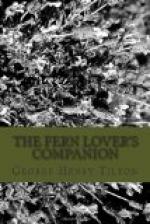[Illustration: A Spray of Maidenhair]
[Illustration: Fruiting Pinnae of Maidenhair]
The maidenhair has a superficial resemblance to the meadow rue, which also sheds water, but it may be known at once by its black, shining stalks with their divisions all borne on one side. It is indeed a most delicate fern, known and admired by every one. The term maidenhair may have been suggested by the black, wiry roots growing from the slender rootstock, or by the dark, polished stems, or, as Clute explains it, “because the black roots, like hair, were supposed, according to the ‘doctrine of signatures’ to be good for falling hair, and the plant was actually used in the ’syrup of capillaire’[A] (Am. Botanist, November, 1921). While the maidenhair is not very common, it is widely distributed, being found throughout our section, westward to California, and northward to the British Provinces.
“Though the maidenhair has a wide range, and grows abundantly in many localities, it possesses a quality of aloofness which adds to its charm. Its chosen haunts are dim, moist hollows in the woods, or shaded hillsides sloping to the river. In such retreats you find the feathery fronds tremulous on their glistening stalks, and in their neighborhood you find, also, the very spirit of the woods.”
MRS. PARSONS.
[Footnote A: It may be stated that capillaire syrup besides the use here indicated was highly esteemed as a pectoral for the relief of difficult breathing.]
[Illustration: Common Maidenhair. Adiantum pedatum (Reading, Mass., Kingman)]
[Illustration: Alpine Maidenhair. Adiantum pedatum, Var. aleuticum (Fernald and Collins, Gaspe County, Quebec, 1906) (From the Gray Herbarium)]
The fern is not hard to cultivate if allowed sufficient moisture and shade. Along with the ostrich fern it makes a most excellent combination in a fern border.
Var. ALEUTICUM, or Alpine Maidenhair. A beautiful northern form especially abundant on the high tableland of the Gaspe Peninsula, Quebec, where it is said to cover hundreds of acres. In the east it is often dwarfed—six to ten inches high, growing in tufts with stout rootstocks, having the pinnules finely toothed instead of rounded and the indusia often lunate, rarely twice as long as broad. (Fernald in Rhodora, November, 1905.) Also found in northern Vermont, and to the northwestward.
(2) THE VENUS-HAIR FERN. Adiantum Capillus-Veneris
Fronds with a continuous main rachis, ovate-lanceolate, twice pinnate below. Pinnules, fan-shaped on slender, black stalks, long, deeply and irregularly incised. Veins extending from the base of the pinnules like the ribs of a fan.
[Illustration: Venus Hair Fern. Adiantum Capillus-Veneris]
While our common maidenhair is a northern fern, the Venus-hair Fern is confined to the southern states. It is rarely found as far north as Virginia, where it meets, but scarcely overlaps its sister fern. The medicinal properties of Adiantum pedatum were earlier ascribed to the more southern species, which is common in Great Britain, but, like many another old remedy, “the syrup of capillaire” is long since defunct.




